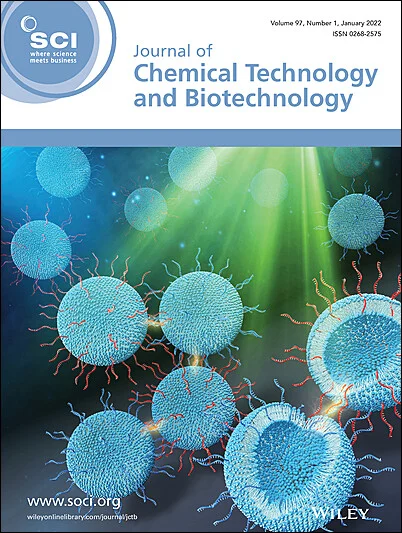Gabriel R. Hernandez-Martinez, Emma O. Fuentes-Ramírez, Cherif Ben Youssef, Juan E. Ruiz Espinoza, Alejandro Zepeda
求助PDF
{"title":"铜离子和铜纳米颗粒对硝化污泥过程的刺激作用:微呼吸和理化评价","authors":"Gabriel R. Hernandez-Martinez, Emma O. Fuentes-Ramírez, Cherif Ben Youssef, Juan E. Ruiz Espinoza, Alejandro Zepeda","doi":"10.1002/jctb.7904","DOIUrl":null,"url":null,"abstract":"<div>\n \n \n <section>\n \n <h3> BACKGROUND</h3>\n \n <p>Copper nanoparticles are used at an accelerated rate in several sectors, generating concern about their impact on human health and the environment. In this study, we characterized the physicochemical behavior and physiological effects of copper ions (Cu(II) ions) and copper nanoparticles (CuNPs) on a nitrifying sludge consortium.</p>\n </section>\n \n <section>\n \n <h3> RESULTS</h3>\n \n <p>Both Cu(II) ions and CuNPs exerted a hormetic effect, stimulating nitrifying sludge biomass. Stimulation was quantified by the percentage of enhancement (<i>E</i><sub><i>OUR</i></sub>), maximum specific oxygen uptake rate (<i>OUR</i><sub><i>max</i></sub>), and substrate affinity constant (<i>K</i><sub><i>S</i></sub>). The results showed that, within the range of 0–20 mg L<sup>−1</sup>, both Cu(II) ions and CuNPs stimulated the nitrifying respiratory process, with maximum stimulation effects of 82.8% and 61.1% at 5 mg L<sup>−1</sup>, respectively. Both Cu(II) ions and CuNPs only increased the <i>OUR</i><sub><i>max</i></sub>, but not the <i>K</i><sub><i>S</i></sub>.</p>\n </section>\n \n <section>\n \n <h3> CONCLUSION</h3>\n \n <p>These findings indicate that copper deficiency could limit nitrogen removal in wastewater treatment. Furthermore, physicochemical characterization allowed us to determine that the observed stimulating effect may be caused by different factors, such as the aggregation, speciation, and adsorption of copper species in the nitrifying sludge consortium. © 2025 Society of Chemical Industry (SCI).</p>\n </section>\n </div>","PeriodicalId":15335,"journal":{"name":"Journal of chemical technology and biotechnology","volume":"100 8","pages":"1716-1723"},"PeriodicalIF":2.4000,"publicationDate":"2025-05-27","publicationTypes":"Journal Article","fieldsOfStudy":null,"isOpenAccess":false,"openAccessPdf":"","citationCount":"0","resultStr":"{\"title\":\"Stimulating effect of copper ions and copper nanoparticles on a nitrifying sludge process: microrespirometric and physicochemical assessment\",\"authors\":\"Gabriel R. Hernandez-Martinez, Emma O. Fuentes-Ramírez, Cherif Ben Youssef, Juan E. Ruiz Espinoza, Alejandro Zepeda\",\"doi\":\"10.1002/jctb.7904\",\"DOIUrl\":null,\"url\":null,\"abstract\":\"<div>\\n \\n \\n <section>\\n \\n <h3> BACKGROUND</h3>\\n \\n <p>Copper nanoparticles are used at an accelerated rate in several sectors, generating concern about their impact on human health and the environment. In this study, we characterized the physicochemical behavior and physiological effects of copper ions (Cu(II) ions) and copper nanoparticles (CuNPs) on a nitrifying sludge consortium.</p>\\n </section>\\n \\n <section>\\n \\n <h3> RESULTS</h3>\\n \\n <p>Both Cu(II) ions and CuNPs exerted a hormetic effect, stimulating nitrifying sludge biomass. Stimulation was quantified by the percentage of enhancement (<i>E</i><sub><i>OUR</i></sub>), maximum specific oxygen uptake rate (<i>OUR</i><sub><i>max</i></sub>), and substrate affinity constant (<i>K</i><sub><i>S</i></sub>). The results showed that, within the range of 0–20 mg L<sup>−1</sup>, both Cu(II) ions and CuNPs stimulated the nitrifying respiratory process, with maximum stimulation effects of 82.8% and 61.1% at 5 mg L<sup>−1</sup>, respectively. Both Cu(II) ions and CuNPs only increased the <i>OUR</i><sub><i>max</i></sub>, but not the <i>K</i><sub><i>S</i></sub>.</p>\\n </section>\\n \\n <section>\\n \\n <h3> CONCLUSION</h3>\\n \\n <p>These findings indicate that copper deficiency could limit nitrogen removal in wastewater treatment. Furthermore, physicochemical characterization allowed us to determine that the observed stimulating effect may be caused by different factors, such as the aggregation, speciation, and adsorption of copper species in the nitrifying sludge consortium. © 2025 Society of Chemical Industry (SCI).</p>\\n </section>\\n </div>\",\"PeriodicalId\":15335,\"journal\":{\"name\":\"Journal of chemical technology and biotechnology\",\"volume\":\"100 8\",\"pages\":\"1716-1723\"},\"PeriodicalIF\":2.4000,\"publicationDate\":\"2025-05-27\",\"publicationTypes\":\"Journal Article\",\"fieldsOfStudy\":null,\"isOpenAccess\":false,\"openAccessPdf\":\"\",\"citationCount\":\"0\",\"resultStr\":null,\"platform\":\"Semanticscholar\",\"paperid\":null,\"PeriodicalName\":\"Journal of chemical technology and biotechnology\",\"FirstCategoryId\":\"5\",\"ListUrlMain\":\"https://scijournals.onlinelibrary.wiley.com/doi/10.1002/jctb.7904\",\"RegionNum\":4,\"RegionCategory\":\"生物学\",\"ArticlePicture\":[],\"TitleCN\":null,\"AbstractTextCN\":null,\"PMCID\":null,\"EPubDate\":\"\",\"PubModel\":\"\",\"JCR\":\"Q3\",\"JCRName\":\"BIOTECHNOLOGY & APPLIED MICROBIOLOGY\",\"Score\":null,\"Total\":0}","platform":"Semanticscholar","paperid":null,"PeriodicalName":"Journal of chemical technology and biotechnology","FirstCategoryId":"5","ListUrlMain":"https://scijournals.onlinelibrary.wiley.com/doi/10.1002/jctb.7904","RegionNum":4,"RegionCategory":"生物学","ArticlePicture":[],"TitleCN":null,"AbstractTextCN":null,"PMCID":null,"EPubDate":"","PubModel":"","JCR":"Q3","JCRName":"BIOTECHNOLOGY & APPLIED MICROBIOLOGY","Score":null,"Total":0}
引用次数: 0
引用
批量引用




 求助内容:
求助内容: 应助结果提醒方式:
应助结果提醒方式:


